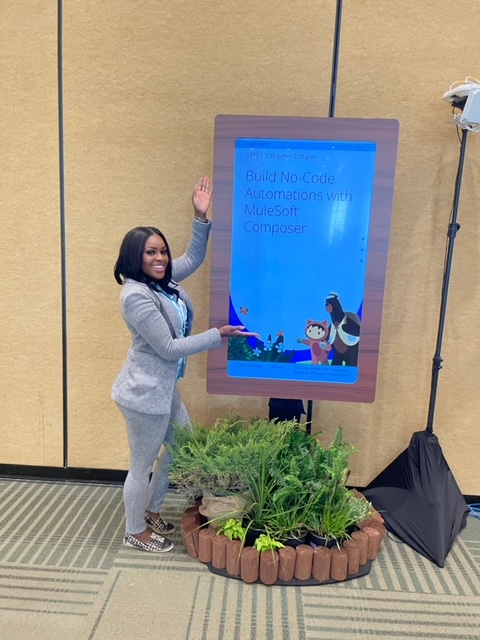Follow along as Salesforce Solution Architect Myra Wilson details her journey with MuleSoft Composer. Learn how her newfound automation and integration skills enabled her to build her own solutions and grow as a professional – all by using clicks, not code.
Meeting MuleSoft Composer
For years, e-Builder (a division of Trimble), had an integration between our CRM and ERP systems that automated the sales process from deals closing to invoicing. The integration had its issues here and there, but one day it broke, and we found out that the functionality would never resume. We had lost all our automation functionality, which meant that the processes needed to be completed manually by the Administrator, me.
Maintaining the sales processes manually meant completing hours of menial tasks on top of my standard role responsibilities. To save time and work more efficiently, my team and I sought out a solution. After some initial research, we discovered that MuleSoft Composer was set to release not long after we came across it. Once we heard that MuleSoft Composer was built in Salesforce and enabled business users to automate integrations using clicks, not code, we were on board.
As e-Builder’s Admin, restoring the integration was solely my responsibility. With no existing documentation from previous workflows, I was prepared to build exclusively from memory of the tasks that the old integration system completed. Thus began my journey with MuleSoft Composer.
From 0 to 100: Getting started with Composer
As soon as I got the green light to get started with Composer, I only had 60 days to build, test, and deploy a new tool – all while keeping up with my admin responsibilities and manually assisting with the sales process. To keep up with demands at work and still deliver on the deployment date, I devoted half of each working day to learning Composer.
I used Trailheads and the MuleSoft Composer Community (a dedicated space for Composer users to ask questions, network, and stay up-to-date on new releases) to self-teach Composer. As an early adopter, I had the added benefit of a dedicated Composer team that consisted of a product manager, engineer, and developer. I was able to meet with the team weekly to help me build out flows, troubleshoot errors, and bounce ideas off of. The access to these resources really turned what could have been a very stressful situation into one of ease.
Becoming a Muley
Throughout my initial 90-day interaction with my Composer team, my spirits and energy remained high. Every meeting was productive, and I provided suggestions on future enhancements from a customer perspective. It was great to know that my story and my use case would be used as inspiration for future product enhancements and users.
Very soon after I had my initial flows built and successfully running, the MuleSoft Community began to reach out to me with amazing opportunities for contribution and recognition. I was invited to the MuleSoft Mentor community, which is a group of highly motivated individuals who are passionate about sharing their MuleSoft knowledge. From there, I went on to participate in several sessions across large conferences such as Trailblazer DX and Dreamforce. I owe many thanks to the MuleSoft Community leads for recognizing me and highlighting my story.

Career growth
After getting Composer implemented at e-Builder and once again automating our sales processes, things were flowing smoothly again. I was now inspired to think about other ways to use Composer. It had the power to transform many of our other internal processes, like integrating with Jira for our DevOps team or partnering with Slack for internal communications. My newfound skill set and knowledge of integrations and automation encouraged me to reach for a new position.
Although being an Admin was fulfilling for the seven years I held in the position, I excitedly accepted a new role as a Salesforce Solution Architect in April 2022. This new role enabled me to use my knowledge to assist in solutioning new projects and integrations. One new project I’m working on is a digital transformation project that will roll 34 Salesforce orgs into one super org.
3 user-tested tips for MuleSoft Composer
As a MuleSoft Mentor and as someone who has worked from start to finish on deploying MuleSoft Composer, here are my top three tips for working with MuleSoft Composer in hopes that it will help others who are currently utilizing Composer or considering becoming a customer.
1. Map out your process before you begin to build your flow
My first experience creating a flow in Composer was coming solely from my knowledge of our previous processes. I had no written step-by-step documentation to refer to, so I had to create my own. I jotted down the steps in a piece of paper, and that was my outline. It made building my flows much easier.
2. Test your flows
Testing is so important before deploying to production and that goes for any newly created flows or processes, or simply updates. Composer makes testing incredibly easy. Within the product, there’s an action to “test” which allows a user to trigger a test on a flow without deploying.
3. Utilize your resources
The Composer Community, Trailhead, and my dedicated MuleSoft team really helped build up my confidence when it came to using Composer. When using a tool for the first time, most people will experience a learning curve, so having resources makes learning curves easier to overcome.
Conclusion
Composer not only challenged me to learn something new in a short amount of time but it was also a catalyst in my career advancement. In my new role I am still using MuleSoft and will continue to utilize it in several areas of our DX project. I’m grateful to share my story and hopefully inspire Admins to be empowered with developing processes they can build with clicks, not code.









